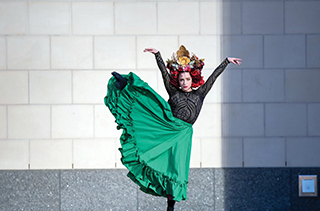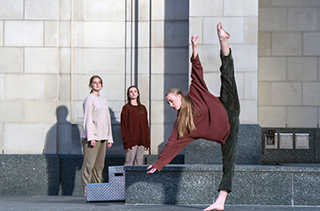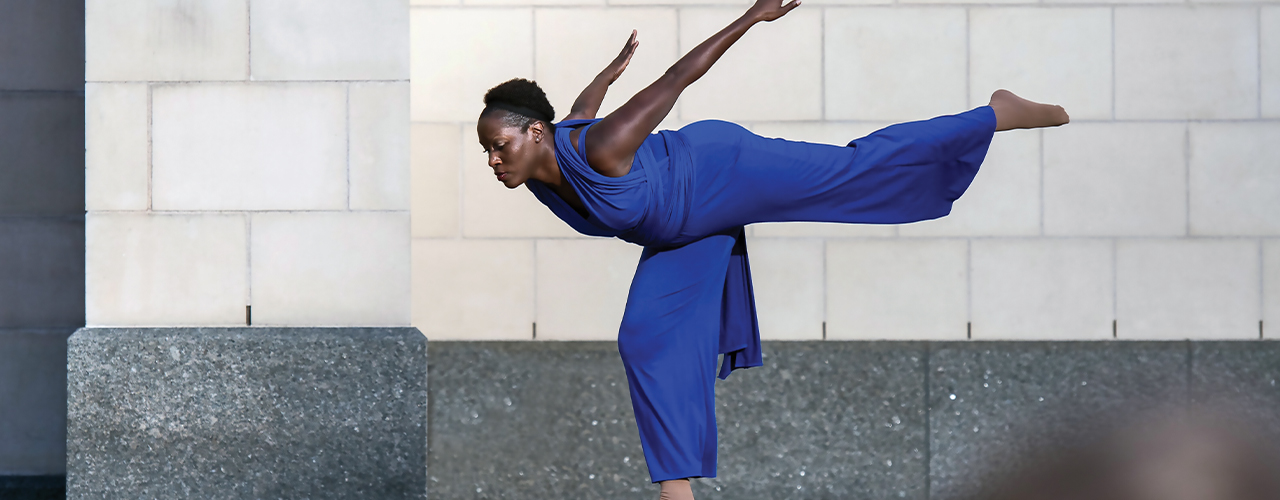The Soul Needs to Move
TCC dance instructors highlight the power of dance and movement
Members of the dance community typically use Albert Einstein’s quote, “Dancers are the athletes of God,” to describe the mix of athleticism and spirituality dancers in all genres display. Many dance forms, especially ballet, are physically demanding, requiring dancers to lean on their endurance, strength and speed to perform.
Scientists agree that dancing is legitimate exercise and can do wonders for the body, leading to greater agility and flexibility, enhanced cardiovascular health, better balance and coordination, weight loss and stronger bones. It can improve mood, too. Fans of “Grey’s Anatomy” will remember Meredith Grey and Cristina Yang routinely “dancing it out” when their days became too stressful.
Whether a person has been performing for years or is new to the art form, Tarrant County College offers an array of dance classes and performance opportunities to students of all ages.
For example, any student interested in joining one of TCC’s touring dance companies—Movers Unlimited at TCC Northeast, Mosaic Dance Project at TCC Northwest, Continuum Dance Company at TCC South and Fusion Dance Company at TCC Southeast—can audition for a roster spot. Students interested in a fun, non-competitive environment can join one of the two community integrated dance companies (the Northeast Dance Company and the Northwest Dance Company).
These programs have enjoyed popularity and critical success largely due to the caliber of instruction.
Read what TCC’s dance faculty has to say about diversity in dance, dealing with bad reviews and why appearing on “Dancing with the Stars” could present a challenge or two.
Instructors
Kihyoung Choi
Professor of Dance, TCC Northeast
Choi started in 2009 as an adjunct professor at TCC Northeast.
Hometown: Seoul, South Korea
Lacreacia Sanders
Associate Professor of Dance, TCC Northwest
Sanders began as an adjunct in 2001 and became full time in 2005. She taught at TCC
Connect as well as TCC Northwest.
Hometown: Fort Worth
Brandy M. Niccolai-Belfi
Associate Professor of Dance, TCC Southeast; Department Chair of Fine Arts since 2019
Niccolai-Belfi started as an adjunct at TCC South in 2007 and moved to TCC Southeast
in 2014.
Hometown: Pittsburgh, PA
Kiera Amison
Instructor of Dance, TCC Trinity River
Amison joined as an adjunct in 2013 and became full-time in 2014.
Hometown: Dallas
Amy Jennings
Associate Professor of Dance, TCC Northwest
Jennings began at TCC Northwest as an adjunct in 2004.
Hometown: Butler, PA
Hyn Jung (Jenna) Chang
Associate Professor of Dance at TCC Northeast
Chang began teaching at TCC in 2018.
Hometown: Daejeon, South Korea
 When did your passion for dance begin?
When did your passion for dance begin?
While most of TCC’s dance faculty shared stories about focusing on dance at an early age, Professor Choi took a more circuitous route—one that included a bit of deception.
Choi: For as long as I can remember, I’ve always wanted to pursue dance. When I was younger, my path was already decided for me—a career as a concert pianist. Since the age of three, that’s what my training was and what my parents wanted. Moving my body, however, had always made me feel so happy and free. Right before the entrance exam to my arts school at age 11, I suffered an arm injury. Although I could play the piano, I used it as an excuse to tell my parents that I couldn’t play, but I could dance. I got in (the arts school) and have been dancing ever since. A moment of ignorant bravery was all it took, and here I am.
Chang: My passion for dance was instilled in me as a child. I started with K-pop covers from the 2000s. I was also inspired by my father who danced in street styles like popping and waving.
Jennings: My earliest memory of dance was a seed planted by my sister. She loved dance, so I loved dance. My mom was also an inspiration. She would talk about her years taking ballet and then show a few dance moves around the kitchen.
Sanders: I began dancing when I was six and was studio trained for most of my childhood. I always enjoyed dancing and never felt forced to attend classes. My passion grew more while in college. It was at that point that I learned dance would become more than just a hobby or something fun to do on the side.
Amison: When I was 14, I began studying dance at the performing arts high school in Dallas. Being immersed in dance at Booker T. Washington High School for Performing and Visual Arts deepened my love and passion for dance, as it afforded me opportunities and experiences with masters in the discipline of dance.
What does dance mean to you?
Jennings: Simply put, life. It is breath in my body, it is home in my flesh, and it is roots in my bones. I have a piece of Walt Whitman’s “Song of the Open Road” taped on my office wall and when I read it, this is dance to me: freedom, love, endurance, compassion, discovery, exploration, poetry and perseverance.
Sanders: To me, dance means freedom, imagination and community.
Amison: Dance for me is a means of expression that is more clear, more honest and more vulnerable than spoken language or song.
Choi: Before, when I was a professional dancer, dancing mainly served to perform, and to receive discipline and hard work. But it made me happy at a personal level, even with its challenges. Over the years, as I’ve taught, it’s become more about humanity.
Chang: Dance, to me, is life itself. Without movement, nothing can be done—so to me, all life is dance.
How would you describe your choreography?
Sanders: I’ve often called it “Lacraecia-ography” as I prefer not to have boundaries within genres. If I want to fuse modern with jazz and ballet with hip-hop, I’ll do it.
Amison: It is important to me that the audience feels something and connects to the work. I’ve seen more works than I can possibly tell you about, but the tones that stick with me are those that made me feel something. It’s what we call an “aesthetic experience.”
Niccolai-Belfi: I do not consider myself a choreographer. However, I think my style of choreography is one of two styles: 1) deeply emotional and featuring a storyline or 2) no storyline and showcasing the dancers’ physicality through very physical, full-bodied movement.
Jennings: My choreography is rich with metaphor and imagery. Whether my concepts are narrative or abstract, I do enjoy threading whimsical moments. I also love the athleticism in my work, movement that is sustainable, details in gestures that help the audience follow is a key for me.
Chang: I started choreographing when I was in middle school. My ideas come from God. I collaborate with Him to create all my works.
Thinking of your students, what are the qualities of a good dancer?
Sanders: A “good” dancer is one who makes use of his or her physical capabilities, not to
mention the life experiences they bring into their performance and creative projects.
Growth is also essential.
Jennings: A dancer who is ready to learn and discover, no matter the level of experience
they have, prepares them to exceed their expectations.
Niccolai-Belfi: Passion, drive and commitment. I believe these things are greater than talent and ability. A dancer can have impeccable technique, but if their heart is not in it, they will not be successful in the field.
Amison: The most important quality is determination and willingness to try. Anyone can dance. It takes time and effort, but anyone who wants to dance, in my opinion, can.
Choi: Dancers with humility are incredibly important. Dancers who are not afraid of being vulnerable and who express and embrace humility can embody and convey the spirit of dance and make others feel something through feeling it themselves.
Any funny stories from the stage or the studio you’d like to share with the readers?
Choi: The first thing that comes to mind is this time when my dancers were performing a traditional Korean drum dance for the International Festival here at TCC Northeast. Sometimes in a drum dance, there can be rhythmic shouting. During the performance, my dancers seemed to be particularly loud in their shouting and moved their feet extremely fast. It turns out that they were dancing on a black marley flooring that had been baking in the Texas sun for many hours prior to the performance. I didn’t even know until the performance was over that the dancers were in pain! It was terrible, but we all laughed the hardest we ever laughed afterwards in the studio together.
Amison: I choreographed a piece about addiction, and it was one of the most hilarious choreographic processes I’ve been a part of. In the dance, we discussed all kinds of addiction: food, drugs, plastic surgery, technology, etc. When working difficult material, dancers need to have the space to laugh, joke and be relaxed when not practicing the choreography.
 How do you deal with a bad review?
How do you deal with a bad review?
Niccolai-Belfi: If my choreography or pedagogical trials end up not being successful, while it may sting, I look at it as a way to grow and improve.
Jennings: At first, there is a bit of indulging in navel gazing and after I swim through this part, I then begin to ask questions of my work. It brings back the curiosity aspect of my work and it helps to shape the review and jump back into the revision part. That’s what I enjoy about choreography, like an artist working through revisions or a chef creating a dish and then adjusting ingredients. A bad review becomes motivating in my craft of renewal and keeping a healthy perspective that art is to invoke a response and not all responses will be good. This is part of life.
Sanders: Any type of criticism brings room for growth and education. It’s also important to remember that a review comes from one person’s perspective.
What are the advantages and disadvantages of mixing different kinds of dancing and working with people from diverse cultural backgrounds?
Jennings: I don’t know that there is a disadvantage to this process. As a dance artist, we do and live this all the time: working with various dance styles, genres and, of course, cultural backgrounds. To me, this is like play time. What is everyone bringing to the group and what can we do together, enjoy together and create together.
Niccolai-Belfi: I do not see any disadvantage with working with a diverse population and with diversity in movement and experiences. People are fascinating, and we all should embrace each other’s uniqueness. As educators, we can learn a lot from other people’s experiences.
Amison: I love being exposed to various cultures and allowing the students to be exposed to that, too. Dance is for everyone and the more we, as a society, are open to various ideas and cultures, the better off we all are.
Sanders: Growth as humans. This is one of the major benefits of the arts.
What’s the most common misconception about dancers?
Jennings: That dancers only dance around and may not require critical thinking skills when, in fact, dancers are exceptional as thinkers and doers. There is consistent refinement in muscle memory, problem solving, timing and scholarly research in our craft.
Niccolai-Belfi: That dancers must be a certain body type or look a certain way. This is not true. Anyone can be a dancer if their heart is set on it.
Choi: “Do a lift.” “Do a spin.” “Oh, so you’re a ballerina?” Dancers take a lot of behind-the-scenes preparation and factors, and not all dancers like to, or can, dance anywhere at any time. Some dancers love improvising and sharing their love for dance in this way, but for others it can be something sacred that requires a lot of time, planning and training.
Sanders: One of the biggest misconceptions is dancers with natural ability or years of classical training who walk into the studio are the only successful dancers. This leaves out an overwhelming number of people in this field who were considered beginners, even as adults. I’ve seen students move from lacking the confidence to blooming into a soloist who commands the stage.
Any advice for high school dancers trying to find the right dance program?
Amison: Visit the campus and watch a class, if possible. The best way to know is to be in the space and see if it feels comfortable/compatible for them.
Niccolai-Belfi: Don’t be afraid to start your training at a community college such as TCC. We will prepare you to move to a university and your credits will transfer, even if they appear as electives. Visit as many schools as you can to find a program that feels right. Go outside of your state and investigate what other colleges and universities offer dance.
Choi: Try to find a program that not only can challenge you but can provide a safe environment for you to be yourself. One that can discover your strength, potential and cultivate your dance experience and embrace that potential.
Jennings: I think it’s important for high school dance students to know their options. They can try out a dance program, attend a masterclass, workshop or audition, or can attend performances of the dance program. This gives insight into where they may envision themselves.
 If you had a chance to appear on “Dancing with the Stars,” which dance style would
give you the most trouble?
If you had a chance to appear on “Dancing with the Stars,” which dance style would
give you the most trouble?
Jennings: Hands down, Tango. And I would gladly take on the challenge, as humbling as it would be.
Amison: Anything in heels would be a challenge. I have Morton’s neuroma in my right foot so most of the dances would be a challenge, but I would try!
Sanders: Anything with a partner…which I know is the primary focus of the show. I love being a soloist, and I love to lead in dance. It would be a challenge to follow and not have the option to improvise if needed.
Niccolai-Belfi: I’m not sure if any of the genres would be particularly difficult; however, I think dancing with a partner would be a challenge for me. Having to stay in contact with them while moving quickly would be difficult, I think.
What else should people know about you and your work?
Sanders: In my work onstage and in the classroom, I want humans to connect. I want us to be reminded that we need others in this world to survive.
Jennings: I will find a way or avenue for dancers to pursue their passion. Dance is for everyone and whether my students are taking classes for enrichment or pursuing the field, there is always a place to belong and to fly. Dance is home in the body and wherever it leads, plant seeds and continue dancing in every facet of life. The soul needs to move.
Choi: My dancers are the most important thing to me. My students at TCC Northeast fill my soul and are the foundation of who I am. I cannot think of my life without them.
What are career paths for your students? Any atypical ones?
Sanders: What I often find interesting is that we have many students come through our program—and return—who are in the medical field. It’s interesting to me that many nurses and therapists also have dance backgrounds or interests in dance. There’s something about movement, the body and the emotional connections we share.
Jennings: There are careers in dance education, dance and business for studio owners, performance and choreography. Interestingly, the number of dancers finding careers on social media has been on the rise. Dance photographers and videographers are needed, and one that should most definitely be pursued is lighting designer for dance. This area needs more technical artistry specific to dance.
Each semester, hundreds of students enroll in dance programs at TCC, which offers a variety of certificate and degree options that can cross discipline with dance.
For more information, visit our Dance program page.


![//parameter[@name='author']](/magazine/assets/images/authors/reggie-lewis.jpg)